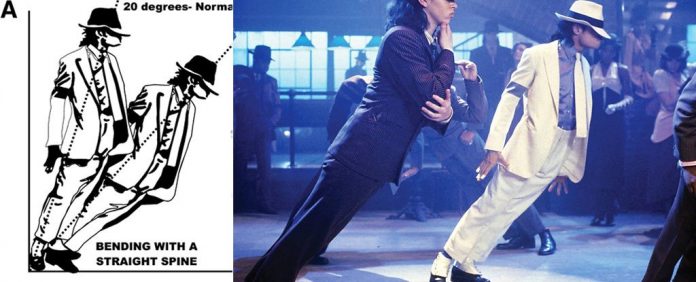Neuroscientists Have Cracked The Science of Michael Jackson’s Gravity-Defying Dance Move.
The late entertainer Michael Jackson is rightly credited for his substantial contributions to popular music, pop culture and (arguably) cosmetic surgery, but until now his equally significant contributions to biomechanics and inventing have gone unsung.
All that has now changed thanks to three neurosurgeons at the Postgraduate Institute of Medical Education and Research in Chandigarh, India, who have solved the mystery of one the performer’s most memorable dance moves.
In the video clip for Jackson’s 1987 hit, “Smooth Criminal”, one scene finds him placing his feet firmly together and flat on the ground, from which position he then leans forward, spine and legs perfectly straight, reaching a seemingly impossible angle of 45 degrees before righting himself again.
Fans could have been forgiven for thinking that such an apparently physics-defying stunt was the result of some post-production special-effects trickery – until Jackson repeated the move, live on stage, during a subsequent concert tour.
Researchers Nishant Yagnick, Manjul Tripathi and Sandeep Mohindra are all avowed Michael Jackson fans – and all have at one point or another attempted to replicate the move. Their motivation is two-fold: first, emulating their idol is cool, but second, and more pertinently, they all specialise in spinal biomechanics.
Their attempts resulted in failure – and minor injuries – which prompted them to start looking for an alternative explanation.
At issue, as they explain in a paper published in the Journal of Neurosurgery: Spine, is the relationship between Jackson’s backbone and his centre of gravity.
When a person bends forward from the hips, keeping the spine straight, a set of muscles called the erector spinae act like cables to support the spinal column as the centre of gravity moves.
Tilting forward with spine and legs straight, however, shifts the action to the Achilles tendons and, if one is not highly trained and blessed with well-developed core strength, a world of pain. Even super-fit professional dancers, Yagnick and his colleagues explain, can manage at most a 30-degree tilt before gravity or paramedics intervene.
Jackson reached 45 degrees, and did so repeatedly in front of very large crowds of witnesses.
Certainly, he was an extraordinary dancer, and at the top of his game in 1987, but these facts alone, the neurosurgeons concluded, could not possibly explain the feat.
So they went searching for an explanation and what they found was surprising. At length, they uncovered a patent – granted in the names of Jackson and his two long-time costume designers Dennis Tompkins and Michael Bush – titled “method and means for creating anti-gravity illusion”.
The invention comprised a system which worked when Jackson, wearing specially modified boots, stood at precisely the right spot on the stage – at which point hook-like devices emerged from the ground and secured the footwear, allowing him to lean forward at a ridiculous angle without toppling forward.
The invention, thus revealed, was very clever – but, as the researchers discovered, Jackson’s anti-gravity move has since inspired hundreds of dancers, professional and amateur, to attempt the trick unaided, with predictable and sometimes painful results.
“MJ has inspired generations of dancers to push themselves beyond their limits,” says Tripathi.
“Though a visual delight, such moves also lead to new forms of musculoskeletal injuries. ‘The King of Pop’ has not only been an inspiration but a challenge to the medical fraternity.”















